Apple Pearl Pink - one of the most unusual varieties of fruit tree, which is obtained as a result of selection work. Of particular interest to gardeners are the fruits of the tree, which are radically different from other varieties and the relative unpretentiousness of the apple tree.
Knowing all the features and taking into account all the individual requirements of the Pink Pearl apple variety, they can also be grown in your backyard.
Table of contents
The origin and description of the variety of apples Pink Pearl
Pink Pearl, a variety of apples, owes its appearance to the American breeder Albert Etter. In 1940, after many years of work, several varieties of apple trees were bred.
The greatest impression on botany produced an unusual look, aroma and taste of apples, derived from the famous apple Nedzwiecki. The original appearance was the reason for the name - Pink Pearl, which was patented in 1944, and the following year was presented in catalogs for gardeners.
Variety of apples with red flesh Pink pearlwidespread in California, Oregon and Washington states among amateur gardeners and on an industrial scale.
Pink Pearl apples have a special color and structure of the pulp. It:
- medium sized fruits;
- delicate translucent peel yellowish-green, less plum-colored with numerous whitish specks;
- juicy fine-grained pulp, painted in whole or in part in raspberry-pink color;
- the taste is sweet and tart with hints of grapefruit and raspberry.
Apple variety Pink pearls are especially valued among people on a diet.. In the fruits of the apple is low in calories, many vitamins, iron and fiber.Due to the original taste and preservation of useful properties after heat treatment, apples are used in cooking in combination with many products, including meat and fish.
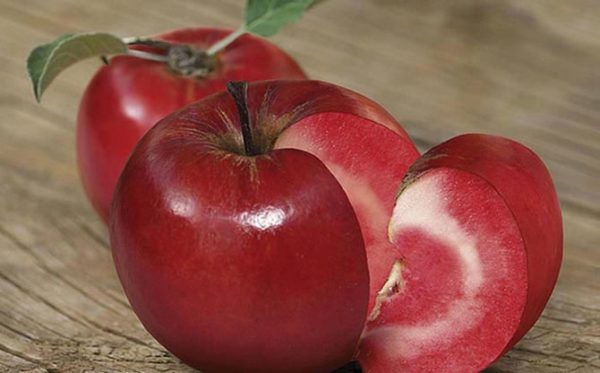
Soil and climate requirements
Apple Pink pearls belong to the autumn-winter varieties with medium frost resistance. Fruit tree can withstand temperatures as low as 30 °. The tree is responsive to sunlight and develops better in well-lit areas. The southern regions will be most favorable for the cultivation of apple trees, and in the northern regions it is recommended to inoculate in the crown zoned frost-resistant varieties.
The Pink Pearl variety apple is a medium-growth tree, reaching up to 7 meters in height. She begins to bear fruit after 3-4 years after planting 2-3 year old sapling. Fruit ripening occurs at the end of August but if you delay the harvest for a month, they will become more saturated and sweet to the taste.
If it is possible to vaccinate, then for the graft it is better to take varieties of apples with pink flesh:
- Suislep,
- Robin,
- Boletus,
- Dresser.
When choosing a landing site, it is important to consider that the tree loves light and heat. Therefore, it is necessary to avoid lowlands, areas shaded and blown by northerly winds.
Landing rules
Seedlings can be planted in spring and autumn. Each landing period has its advantages. If a tree is planted in the fall, over the winter its roots will adapt to the soil and harden, and with the appearance of the first heat in the spring it will actively develop.
This period of time is more suitable for the southern regions and rich black soil. Favorable time for landing from September 20 to October 15.
The advantage of planting in spring is a good strengthening of the tree before the onset of winter, which guarantees a stable transfer of low temperatures in the first year of development. Planted seedlings in the period from April 20 to May 10. The peculiarity of spring planting is frequent and abundant watering in the first weeks of seedling development, this will help avoid drying out the roots.

Soil preparation
For apples with red pulp, you need to choose a place where the groundwater lies at a depth of 2.5 meters.An 80-cm-deep pit is dug in the selected landing site, which is best prepared a week before planting. The bottom of the hole additionally loosened at 25 cm in depth.
After that, the 1/3 pit is filled with humus soil, which is saturated with fertilizers:
- superphosphate (200 g),
- potassium sulfate (80 g),
- wood ash (200 g),
- manure (3 buckets).
Minerals and organic matter are mixed by adding fertile soil to them. Thus, in the root zone, good nutrition is provided, and an optimal substrate is formed for quick adaptation of the seedling to a new place.
The rest of the pit is covered with soddy soil until a mound forms, which rises 15 cm above the ground. In the middle of the prepared landing site, you need to drive a wooden stake 50 cm above the ground level.
Planting seedlings
Despite the careful selection of the seedling at the time of purchase, it should be re-examined before planting. The rotted and injured areas of the roots and the stem are cut with a sharp knife to healthy tissue. Before planting, the roots of a seedling are recommended to be dipped into a clay-dung talker, which contains growth regulators that stimulate the active development of the fruit tree.
The first stage of planting apples Pink Pearl is the location of the seedling on the north side of the prepared stake, while you need to make sure that the roots diverge in different directions evenly. It is necessary to ensure that there are no voids between the roots, for this the stem is slightly shaken when the substrate is filled.
After the roots are powdered, the soil is slightly compacted with the feet and ground is added to the sod. A hole is formed around the circumference, where 2 buckets of warm water are poured in and covered with earth. The soil around the seedling is mulched with peat, straw or manure - this will protect the roots of the young tree from drying out. The seedling is tied to a peg with a free loop using a twine.
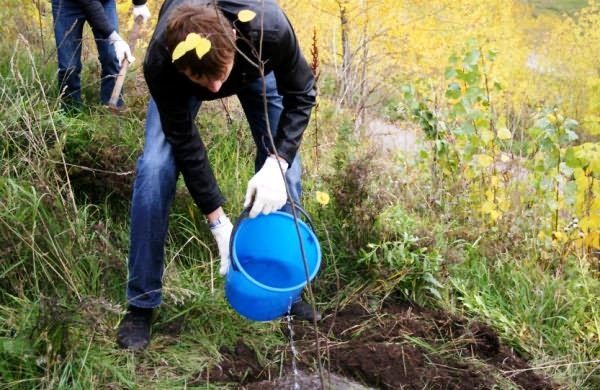
Apple care
The variety of apples with pink pulp Pink pearls require more careful care in the early years of their development.
Top dressing
In the first year for the full development of seedlings enough fertilizers that were made during planting.In subsequent years, the apple tree should be fed organic and mineral fertilizers:
The soils depleted during the winter do not provide the nutrition needed for the fruit tree. In the spring, it is especially important to introduce nitrogenous fertilizers in the phase of swelling of the kidneys. They are introduced into the basal circle, after prikopav soil to a depth of 10 cm. For spring dressing fit:
- urea (500 g), diluted in water (50 l);
- a solution of manure and water 1: 8;
- bird droppings bred in water 1:15.
Consumption per apple tree is 15 liters.
The second dressing is done in the phase of setting the first fruits with sodium fertilizers. To do this, you need 1 kg of nitrophos and 20 g of sodium humate diluted in 200 liters of water. The resulting nutrient solution is shed in the near-stem zone, spending 3 buckets on each apple tree.
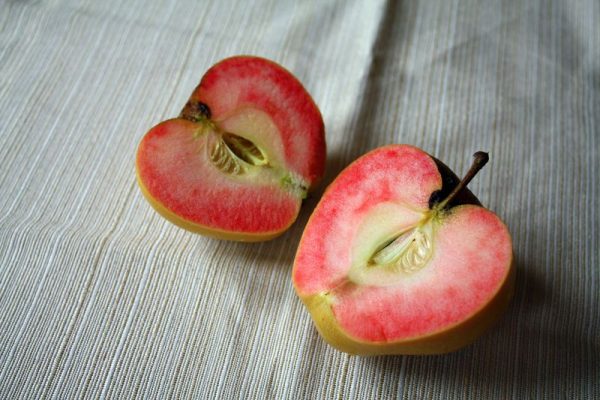
For young trees that do not bear fruit, autumn fertilization with phosphate and potash fertilizers is important. They are introduced into moist soil during digging or bred in 2 tbsp. l 10 l of water and shed the soil around the trunk, spending 2 buckets on one apple tree.
Watering
Young apple trees need frequent watering, at least 4 times per season.Water is evenly distributed on the soil in the tree trunk area.
Formed around an apple tree water depth of 10-15 cm will help to avoid unwanted exposure of the roots during watering. ATIt is important that the moisture reaches to the depth of the active roots, in the Pink Rose pearl apple tree it is 60-70 cm.
Depending on the age, the tree needs different amounts of water:
- annual saplings 2-3 buckets;
- biennial apple 4-5 buckets;
- three years and more trees at least 5-8 buckets.
Terms of watering are completely dependent on climatic conditions.. The first moistening is carried out before bud break. If the weather is hot and dry, trees under five years old should be watered at least once every two weeks. For adult trees, the second irrigation is carried out after the flowering phase, in the period of mass fruit set.
The last watering is carried out during the ripening period of apples 2 weeks before harvest. Irrigation during the collection of fruits and after that should not be, it can lead to the active development of young shoots and to the weakening of the tree before the winter period.

Pruning
A properly formed apple crown is a guarantee of the quality of the fruit and the amount of the crop. Trees of apple varieties Pink pearls begin to trim in the first year after planting. The optimal time for pruning is the rest period of the sapling.
To do this, choose late autumn, it is important that the air temperature was at least -10 ° C. Pruning in severe frosts leads to the fragility and vulnerability of apple trees to disease.
Removed deformed, dried and frozen branches. Apple pruning is done every year, avoiding excessive development of side branches and tree tops.
Preparing for the winter
Lime mortar is used for whitewashing the lower part of the trunk of an apple tree. This will protect the wood from frost damage during temperature fluctuations that cause the formation of rot. The calcareous layer will prevent possible sunburns in the winter and spring, will protect from rodents.
The addition of insecticides to the solution is a good prevention against pests that remain to overwinter in the bark. Young apple trees are bleached without preparation, and in mature trees, dead bark, lichens and moss are removed.The best time for whitewashing is the third decade of autumn, when torrential rains cease and a stable minus temperature is established.
Insulation with a layer of mulch will prevent the tree roots from freezing. For this purpose, the hardening of the trunk circle to a height of 30-40 cm is carried out, and a layer of peat of 5 cm is applied. To avoid breaking the side branches under the weight of snow, they are tied to the trunk.
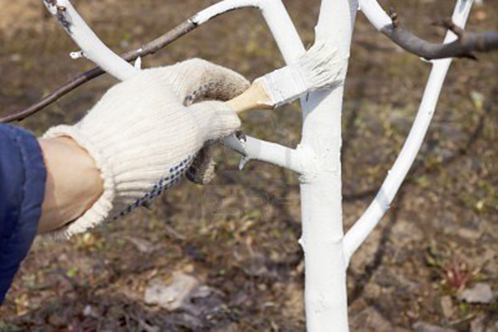
Pests and diseases
Fruit tree is most susceptible to the appearance of fungal diseases - scab and powdery mildew. In diseased trees, cracks, rot and yields are significantly lost, and the fruits grow irregularly shaped.
Increased dampness can trigger another type of disease - fruit rot, which grows on ripe apples and can completely spoil the crop.
Comprehensive treatment of apple for fungal diseases:
- destruction of the source of infection - diseased leaves, fruits;
- spraying of a circle with a 10% solution of ammonium nitrate;
- use of the drug Scor in early spring;
- spraying with HOM (4%) after flowering;
- wood treatment with 7% urea solution before winter.
Autumn destroys or bury all affected plant waste. Many gardeners are fighting fungal diseases by spraying with a solution of salt (1 kg) and water (10 liters). Processing is carried out before bud break.
Red Pulp Apple Pests
Tree pests are the most dangerous for apple trees - the bark beetle, scab, and mites. They climb into the bark, which greatly complicates the work of destruction. To reduce the number of pests, the bark of the tree is treated with a solution of urea (7%) or copper sulphate (7%).
No less dangerous for apple trees are pests that feed on leaves and fruits, sucking up most of the nutrients from the tree:
- fruit picker
- apple aphid
- hawthorn
- sucker,
- scythe,
- apple blossom tree,
- leafworm,
- sawflies.
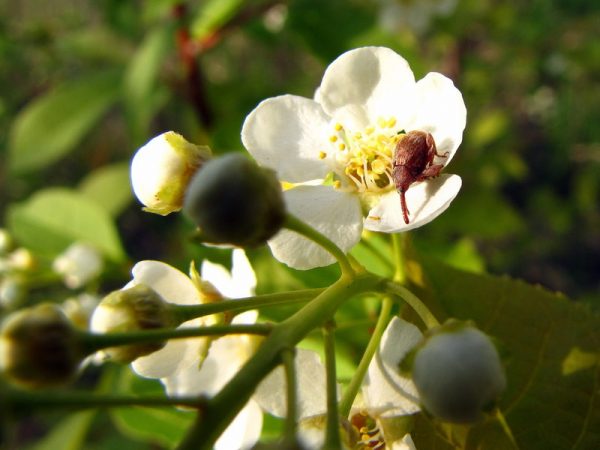
The first treatment from pests is important to do before bud break., getting the solution on the open kidneys can cause a burn. Spraying is carried out with a 7% urea solution, the wood and the soil under it are processed.
At the same time, a protective treatment is being done to increase resistance to diseases and pests, the following drugs are used: Zircon and Ecoberin. Work on the destruction of pests are carried out before flowering or after within 5-7 days.
Gardeners reviews
Helena: These are unusual apples that were bred in California, and scientists still continue to work on them. Friends who have tried them, speak of an unusual taste with surprisingly berry notes. Fruits do not lose their taste and light during cooking. Do not become brown and do not oxidize. Interestingly, the variety bred for more than 20 years. I plan to plant it next year.
Sergei: We have such an apple tree. The color of the fruit at harvest time should be greenish-yellow, then they grow out and get a golden hue, which means that the apples are ready to eat. Often the fruit is quickly showered from the tree.
Albina: I read about apples Pink pearl about three years ago, I had a burning desire to plant in my area. Unfortunately, the seedlings destroyed rodents. Now they have planted everything according to the rules, we will wait for the results The trees are only one year old, they develop and look very good, the leaves and stems are healthy. Saplings bought in the nursery, where I was given detailed instructions, which greatly facilitated the planting and care.
Planting in the garden of apple varieties Pink Pearl is attractive for gardeners interested in exotic plants and aesthetes, which will not leave indifferent the unusual flowering of the fruit tree. Large yields and long storage without processing will provide the whole family with vitamins and minerals for a long period.
